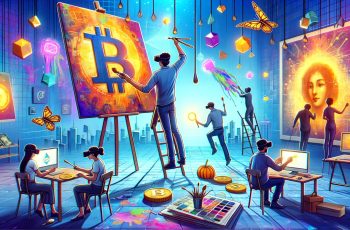The concept of the metaverse, a shared virtual space where users can interact with digital objects and each other, has captured the public imagination in recent years. With the rise of blockchain technology and cryptocurrencies, a new breed of metaverses has emerged – crypto-based metaverses that leverage the power of decentralised ledgers and digital assets to enable unique forms of social interaction and collaboration.
Crypto-based metaverses as social platforms
Crypto-powered metaverses are basically virtual social environments where users can engage and showcase themselves in creative ways. Metaverses, as opposed to traditional social media sites, provide shared virtual spaces where individuals can gather, engage, and engage in group activities while experiencing a strong sense of presence.
A crucial feature of crypto metaverses is the ability for users to create and control anonymous digital identities. By using blockchain authentication and digital assets like NFTs, people can make unique avatars and social profiles that they truly own and control. This enables greater ease and imagination in expressing oneself, as well as improved protection and management of personal information.
Crypto metaverses are allowing vibrant social groups and communities to form based on common interests and values, going beyond personal identities. Decentralized governance systems enable users to collaboratively influence the regulations and standards of these online environments, promoting a deep feeling of shared ownership and community.
Some prominent examples of social crypto metaverses include:
- Decentraland: A user-owned virtual world where people can socialise, build, and monetize immersive experiences
- The Sandbox: A decentralised gaming metaverse where creators can design, share, and monetise voxel assets and games
- Somnium Space: An open, social VR world with a focus on immersive events, experiences, and virtual real estate
These platforms are pioneering new models for social interaction and community building that empower users and creators in groundbreaking ways. Through avatar-based communication, customisable environments, and collective ownership, they are redefining what it means to connect and belong online.
Fresh possibilities for working together and creating collectively
Crypto-powered virtual worlds are not only facilitating unique ways of interacting with others, but also opening up new avenues for working together on creative projects and finding solutions to challenges. These platforms enable users to collaborate and create in new ways that were not achievable before, thanks to open and flexible virtual environments.
One of the key features of crypto metaverses is the capability for users to work together in constructing and exchanging virtual spaces and experiences. By utilizing in-world building tools and programmable assets, individuals have the ability to collaborate in order to create immersive environments, games, and interactive artworks that are solely confined by their shared creativity. This shared construction process promotes a deep sense of collaboration and shared ownership, as participants are actively constructing the virtual world together step by step.
Crypto metaverses are facilitating novel types of creative partnerships among artists, designers, and developers as well. These platforms enable creatives to collaborate seamlessly across different fields by offering open standards and interoperable resources.
For instance, a 3D artist could design a distinctive avatar or virtual structure, a fashion designer could create personalized clothing for it, and a game developer could incorporate it into an interactive metaverse – all within a communal, accessible platform.
Some exciting examples of collaborative creation in crypto metaverses include:
- Community-built cities and museums in Decentraland, with thousands of user-generated buildings and artworks
- Blockchain-based game jams and hackathons in The Sandbox, where developers come together to rapidly prototype new experiences
- Collaborative VR art exhibitions in Somnium Space, featuring works by artists from around the world
By enabling collaborative creation at scale, crypto metaverses are driving a Cambrian explosion of creativity and innovation. These platforms are empowering creatives to work together in ways that were previously impossible, resulting in richer, more diverse virtual worlds and experiences.
Fostering global connections and cultural exchange
One of the most transformative aspects of crypto-based metaverses is their ability to foster connections between people across geographic and cultural boundaries. By providing shared virtual spaces that are accessible from anywhere in the world, these platforms are enabling people to come together and interact in ways that transcend physical distance and borders.
In a crypto metaverse, a user from London can easily meet and socialise with users from Tokyo, Rio de Janeiro, or Cape Town, all within a shared virtual environment. This globalised social interaction exposes people to a rich tapestry of cultures and perspectives, fostering empathy, understanding, and collaboration across diverse communities.
Crypto metaverses are also serving as hubs for cross-cultural events and experiences. From virtual music festivals featuring artists from around the world, to international art exhibitions and conferences, these platforms are providing new venues for cultural exchange and celebration.
Some notable examples of global communities and events in crypto metaverses include:
- The “Global Village” community in Decentraland, which brings together users from over 100 countries to socialise and collaborate
- The “International Art Week” event in Somnium Space, featuring VR exhibitions by artists from across Europe, Asia, and the Americas
- The “Metaverse Pride” celebration in CryptoVoxels, which brought together LGBTQIA+ communities from around the world for a virtual parade and party
By connecting people across borders and cultures, crypto metaverses are helping to build a more globalised, empathetic society. These platforms are breaking down barriers and enabling people to come together in shared virtual spaces, fostering greater understanding and collaboration across diverse communities.
Economic empowerment and inclusion
In addition to social and cultural advantages, metaverses based on cryptocurrency are also leading to substantial economic empowerment and inclusion. These virtual worlds are creating new economic opportunities and reducing barriers to entry for people globally by offering open, accessible platforms for creation and trade.
The capacity for users to generate, possess, and exchange virtual assets is a crucial economic factor in crypto metaverses. Through the use of blockchain-based tokens such as NFTs, individuals have the ability to create one-of-a-kind digital items – ranging from virtual property to wearable fashion pieces to interactive art pieces – that are completely under their ownership and management. Users are able to generate actual economic value from their creations by buying, selling, and trading these assets on open marketplaces.
This virtual economy, owned by users, is creating novel ways for creatives, entrepreneurs, and everyday users to earn money. Artists and designers can make money using their skills by producing and selling virtual items, while developers can earn income by creating and monetizing immersive experiences. Even people who are not serious gamers can make money by getting involved in play-to-earn games or leasing out their digital property.
The open and permissionless characteristics of crypto metaverses are crucial in reducing entry barriers and promoting participation in comparison to traditional economies. Users only require a crypto wallet and an internet connection to take part; they do not need access to banking infrastructure or credit. This is leading to increased economic participation, especially for marginalized communities and users in developing countries.
Some powerful examples of economic empowerment in crypto metaverses include:
- The thriving virtual fashion scene in Decentraland, with independent creators minting and selling unique wearables and accessories
- The booming “play-to-earn” economy in The Sandbox, where gamers can earn real crypto rewards by playing and creating games
- The growing network of virtual landlords in Somnium Space who are generating passive income by renting out parcels of virtual real estate
By enabling user ownership, lowering barriers to entry, and providing new earning opportunities, crypto metaverses are driving a more inclusive and equitable virtual economy. These platforms are empowering creatives, entrepreneurs, and everyday users to generate real economic value, regardless of their background or location.
Challenges and considerations
Although there are vast potential benefits to crypto-based metaverses, it is crucial to recognize and tackle the challenges and considerations that accompany this new frontier. Like any new technology, addressing technical, social, and governance challenges is crucial for the positive and inclusive development of these platforms.
A major hurdle is the existing technical obstacles to entering and accessing crypto metaverses. A lot of these platforms need specific equipment such as VR headsets or top-of-the-line computers for users to access, which may be too expensive for some people. Non-technical users may find it challenging to navigate blockchain wallets and cryptocurrencies due to usability barriers.
Metaverse developers must strive to create onboarding experiences that are more accessible and user-friendly in order to achieve widespread adoption and participation.
Another important factor to think about is the requirement for efficient content moderation and community governance on these decentralized platforms. Although the open and unrestricted aspect of crypto metaverses is advantageous, it also presents difficulties in terms of regulating community standards and avoiding negative content and behavior.
Metaverse communities will have to create strong governance systems and moderation tools to guarantee secure and welcoming spaces, all while upholding decentralization and user independence.
There is a potential danger that crypto metaverses could magnify echo chambers and isolated communities, as individuals are drawn to similar groups and ignore opposing viewpoints. Metaverse developers and communities need to make a deliberate effort to promote diversity, support positive discussions, and connect diverse groups.
Ultimately, just like in any digital space, privacy and security are top priorities in crypto metaverses. Risks such as identity theft, financial fraud, and data breaches exist when users interact through pseudonymous avatars and conduct financial transactions. Metaverse designers need to focus on secure authentication methods, data protection, and user privacy when creating and running these platforms.
“The challenges facing crypto metaverses are significant but not insurmountable. By proactively addressing issues of accessibility, governance, inclusion, and security, we can work towards metaverse environments that are empowering, safe, and beneficial for all.” – Giovanna Graziosi Casimiro, Head of Metaverse Fashion Week
Conclusion
The emergence of crypto-driven metaverses signifies a crucial turning point in the development of the internet and human connections. These immersive, decentralized platforms are not only allowing for new types of social bonding and artistic communication – they are establishing the groundwork for a digital future that is more open, inclusive, and empowering.
As we have examined, the social consequences of crypto metaverses are extensive and varied. These digital realms offer fresh opportunities for fostering camaraderie and a sense of belonging, facilitating joint innovation and conflict resolution worldwide, promoting intercultural communication and empathy, and boosting economic prospects and inclusivity for individuals globally.
Although there are obstacles and factors to think about, the potential for crypto metaverses to bring about positive social change is huge. By persisting in creating and developing with an emphasis on accessibility, governance, diversity, and user empowerment, we can strive towards metaverse environments that enhance the potential of both individuals and society overall.
FAQs
Oh, totally! By leveraging DAOs and smart contracts, crypto metaverses create decentralized communities where users have governance tokens to vote on ecosystem changes. It’s like being part of a digital cooperative—super empowering!
Crypto metaverses are game-changers for collabs! They provide platforms where developers and creatives can co-create using NFTs and blockchain tech. Plus, they enable cross-project interoperability, meaning assets and ideas can flow seamlessly across different virtual environments.
Blockchain is the backbone here, ensuring transparency and immutability. Every transaction or interaction is recorded on the blockchain, making fraud nearly impossible. This builds trust among users, as they know their contributions and ownership are protected.
Absolutely! They bridge digital and physical realities, supporting causes through fundraising and awareness campaigns using crypto tokens. They’re not just about gaming; they’re platforms for social change, amplifying voices globally through decentralized networks.
While the potential is massive, risks abound. Volatility is high, and regulatory landscapes are still forming. Plus, liquidity issues can arise, impacting token values. Always DYOR (Do Your Own Research) before diving in—understanding the tech and the market is key.




